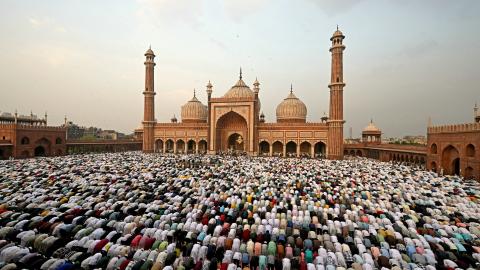Despite significant study of Salafism over the past few decades, much of the research continues to be focused on the Middle East and Europe.1 Even though the majority of the world’s Muslims reside in other regions such as South and South-East Asia, insufficient attention has been given to the manner in which this literalist practice of Islam according to the understanding of the first three generations of Muslims engages with politics or antagonizes against the ideas of democracy and secularism in regions such as India. While a large portion of scholarly and media attention has been devoted to connecting Salafism to violence, a trend that has changed somewhat over the last few years with more nuanced discussions regarding Salafists’ positions on violence, the particular political context of countries in which Salafist movements reside holds a significant role in influencing Salafist participation in politics.2
This article seeks to contribute to our understanding of how Salafists approach the idea of democracy and secularism in India. This is an important gap given that there are close to 200 million Muslims in India and, according to some Salafist claims, around 30 million Salafists in the nation. The total number of Indian Muslims dwarfs most Arab Muslim populations and should play a significant role in re-configuring how academics understand Salafism and its relationship to politics.
The article first charts out the two major Salafist organizations, the Kerala Nadwatul Mujahideen (KNM) based in the southern state of Kerala and the Markaz Jamiat Ahl e-Hadith (MJAH), which is based across parts of southern and northern India. Combined, the two organizations claim to command more than 30 million followers. Second, this study examines how Salafists approach the ideas of democracy and secularism in India and how that manifests in their participation in electoral democracy, drawing on my various interviews with key Salafist figures in India between 2021 and 2023 alongside analysis of the organizations’ videos and texts produced in English, Urdu, Malayalam, and Hindi. Notably, this article examines how Indian Salafists approach the rise of Hindu right-wing partisanship in India in the form of the current government, the Bharatiya Janata Party (BJP).
Specifically, I argue that the KNM and MJAH have supported secularism to protect religious freedom and participate in Indian democracy as a pragmatic necessity. The reasons for engaging in democracy are not uniform across the board, with some Salafists doing so merely out of the necessity to engage in what they deem an imperfect (and ordinarily impermissible) system, while others wholeheartedly embrace democracy as another tool for Muslims to engage with and live in the modern world. This study also contends that Salafist responses to the BJP and Hindu nationalism in India are mixed, with some groups cautiously engaging with BJP while others vocally oppose the party and its policies.
This study begins with a brief discussion of Salafism that draws on the topic’s secondary literature and examines how Salafist terminologies are used in the Indian context with, for example, the term Wahhabism historically being used as a pejorative dating as far back as the 19th century. It further examines the history of KNM and MJAH and their relationships with Saudi Arabia and other Gulf nations. The study then provides an assessment of the main positions of the two groups on different issues of politics, including their respective responses to the rise of the BJP in India.
This study provides much-needed insights into the various debates on Salafist approaches to secularism and electoral democracy. In doing so, it shows that studies of Salafism have been overly reliant on a few regions of the world and that our understanding can be improved by bringing in perspectives from other regions such as India. The article can also help policymakers understand the different responses that Salafists take to politics and questions of religious radicalization and violence, showing that Salafists engage in a range of political attitudes and behaviors toward the modern state. Lastly, this study sheds light on the different reactions among Indians to the rise of the BJP and what many scholars have characterized as an attendant erosion of minority rights and increase in intercommunal violence.
“Salafism” and Related Terminologies in India
Salafism, at its core, is a belief system rooted in a literalist understanding of the Qur’an and Hadith (the recorded sayings of the Prophet Mohammed) that emphasizes the practices of the first three generations of Islam, as those generations are deemed closest to the Prophet Mohammed and least corrupted. Salafists focus on theological purity, thus rejecting any rituals not practiced by the Prophet’s companions and avoiding complete adherence to any one of the four traditional schools of Sunni jurisprudence, preferring instead to rely solely on evidence from the Quran and Hadith.3 Although the term Salafism is broad and contested, in the context of this study it is more accurate than referring to “Ahl e-Hadith,” which refers specifically to Urdu-speaking Salafists in India and Pakistan and is sometimes used to denote all Indian Salafists by South Asian scholars.4 Ahl e-Hadith is derived from the Arabic Ahl al-Hadith, which was historically used to denote scholars who prioritized the Qur’an and Hadith over scholarly opinion.
The term Salafiya officially entered the lexicon of the Ahl e-Hadith in colonial India in 1918 when Madrassa Ahmadiya was renamed Madrassa Ahmadiya Salafiya in Bihar.5 Despite Salafism being a broader term, Ahl e-Hadith has become synonymous with South Asian Salafism due to the dominance of the Urdu language among Muslims in India and Pakistan.6 However, this term was historically less common in regions such as Kerala and coastal Karnataka where languages like Malayalam prevail. In Kerala, Salafists often refer to themselves as mujahideen, aligning with the Kerala Nadwathul Mujahideen movement (KNM), while in coastal Karnataka, they identify as Salafi, as seen in the South Karnataka Salafi Movement.7 Despite the associations of the term mujahideen with armed Salafi jihadism, in the context of the Kerala Mujahideen, the name refers to the organization’s focus on self-purification rather than armed jihad.
Despite regional differences in nomenclature, both northern and southern Salafists use the term “Salafi” to describe their institutions and scholars. Notable examples include Jamia Salafiya Varanasi (one of the most famous Salafi madrassas in India formed in the 1960s) and prominent figures such as Tariq Saudagar Salafi from Bangalore and Imam Asghar Ali Mehdi Salafi from Delhi. Even in Kerala and coastal Karnataka, it is common to see scholars adopting the “Salafi” suffix, such as Hussain Salafi from Kerala.
Wahhabism and terrorism
In the present day, the term “Wahhabism” has also been used in Indian society to denote Salafists, mainly as a pejorative term linking them to terrorism. Yet this term has a deep history with the Ahl e-Hadith movement in India originating in the 1830s with Sayyed Ahmed Barelvi's rebellion in the Northwest Frontier. Barelvi, who promoted monotheism and opposed Sufi practices such as shrine visitation, was labeled a Wahhabi by his critics, which was understood to be the purist and militant Islam originating from the Nejd region of Saudi Arabia that was gaining broader prominence at this time.8 This association between Wahhabism and certain Indian Muslim movements strengthened during the 1857 Sepoy Mutiny, as the British, disturbed by the uprising, conducted “Wahhabi trials” against Muslims, thus embedding the term in their official lexicon by 1864.9 British literature further vilified Wahhabis as rebels and barbarians.10
Indian Muslims also used “Wahhabi” pejoratively to criticize opponents of Sufi practices.11 By the late 1880s, Ahl e-Hadith members in Punjab had sought legal action to ban the term's use, but it persisted in official documents until the 1940s.12 So-called social reformers who called for changes in religious practice (including engaging women in education) such as Vakkom Maulavi faced similar criticism when spreading the teachings of Syrian-born intellectual Rashid Rida, who is credited with energizing the Salafist movement across the world around the turn of the 20th century.13 In the 1930s, non-Salafist scholars in India opposed the establishment of the modern Saudi state, labeling it the Wahhabi Kingdom.14
Despite the minimal direct influence of the teachings of Mohammed Ibn Abdul Wahhab (the founder and namesake of Wahhabism, who helped establish the kingdom of Saud in the 18th century) on early Indian Salafists,15 the term's negative connotation has persisted. Non-Salafists continued using the term to describe critics of Sufism in the post-independence era. Especially after the September 11 attacks, global and Indian media revived the term to discuss Salafist influences in the country, typically in a negative light.16
A Brief History of Salafism in India
The Salafist presence in northern India can be traced back to Shah Waliullah Dehlawi (d. 1762), a prominent 18th-century theologian who revitalized Hadith studies in the subcontinent. Dehlawi, a contemporary of Mohammed ibn Abdul Wahhab, studied in the Hijaz region of Saudi Arabia during the same period and shared at least one teacher, Mohammed Hayat al Sindi, with Wahhab. Dehlawi’s influence extended to the Deoband and Ahl e-Hadith movements, both of which incorporated different aspects of his teachings.17
Dehlawi’s son, Shah Abdul Aziz, further propagated his father’s teachings and mentored Syed Ahmed of Rae Bareli town in present-day Uttar Pradesh. Ahmed led a battalion of Muslims in the Northwest Frontier region of British India in 1831 to fight both British and local Sikh and Hindu forces. Although his organization, the Tariqa Mohammediya, initially saw some victories during its campaign, it ultimately ended in defeat. Despite this, the Ahl e-Hadith movement later emerged, influenced by non-violent methodologies of some of the scholars following Ahmed and Dehlawi.18
Syed Ahmed, inspired by the rise of Ibn Abdul Wahhab’s movement during his Hajj pilgrimage, returned to India to preach jihad. He gained significant support from the Sadiqpur family in Patna in Bihar state and spread his teachings across India through various emissaries, including Wilayat Ali and Inayat Ali, who notably influenced the Nawab (ruler) of Hyderabad.19
Two key figures in the dissemination of Salafist ideology in North India were Syed Nazeer Hussain Muhaddith Dehlawi (d. 1903) and Syed Siddiq Hassan Khan of Bhopal (d. 1890). Nazeer Hussain, deeply influenced by Syed Ahmed’s activities in Bihar, founded Madrassa e-Nazirriya and taught many prominent Ahl e-Hadith scholars. Siddiq Hassan Khan, based in Bhopal, was a prolific writer with over 200 books in Urdu, Persian, and Arabic. Influenced by Yemeni scholar al-Shawkani, Khan’s writings shaped the Ahl e-Hadith movement’s doctrines.20
The Ahl e-Hadith movement formally organized itself into the Markaz Jamiat Ahl e-Hadeeth (MJAH) in 1906 with the All-India Ahl e-Hadeeth conference. Throughout the 1940s, debates over the creation of Pakistan led to a split within the movement, with some factions opposing the idea.21 The demand for a separate state for Muslims (Pakistan) arose due to anxieties that Muslims would not be treated well in a post-colonial India dominated by Hindus.22 This stance was, however, opposed by different groups of Muslims in the sub-continent, with some arguing that the movement for a separate state of Pakistan would create disunity in the anti-colonial struggle and others arguing that Muslims would be stronger in an undivided India. The debate was ultimately settled in 1947 with the formation of a separate Pakistani state.23
The movement gained substantial momentum with the establishment in 1966 of the Jamia Salafiya Varanasi, an influential Salafist seminary in Uttar Pradesh, which was inaugurated by eminent Saudi figures. The Jamia became a focal point for most major MJAH clerics who went on to study there before moving to other places like Madina University in Saudi Arabia.24 Today, the Ahl e-Hadith organization has a significant presence in 21 out of 28 states along with 200 district-level branches and 40,000 local branches across the country.25
A distinct Salafist movement in the southern state of Kerala originated in the late 19th century as a reform initiative inspired by Egypt-based reformers Mohammed Abduh and Rashid Rida. Syed Makti Tangal, a prominent early figure of this movement, called for educational reforms and women’s rights in the 1890s, influencing later reformers such as Vakkom Maulavi, who, among other things, argued in the early 20th century against traditional practices such as shrine visits and the veneration of community leaders. This movement gained significant traction, leading to the formation of the Kerala Nadwathul Mujahideen (KNM) in the 1950s, which emphasized religious purification and educational reforms, including using the Malayalam language in sermons and the madrassa education system.26
The KNM's integrationist approach promoted women's education and participation in religious activities, significantly shaping Kerala's Muslim community. As of 2015, the KNM ran over 1,100 madrassas with more than 35,000 students, over half of whom were women.27
Internal disagreements led to splits within the KNM. A group known as the Markazudawa faction broke away in 2002 under Hussain Madavoor, only to re-merge with the broader group in 2016 due to external pressures such as Hindu nationalist activities and concerns about Keralites joining the Islamic State. Another faction, the Wisdom Global Islamic Mission, emerged in 2015, advocating a stricter understanding of monotheistic theology that views local faith groups as overly superstitious.28 While the original KNM still exists today, smaller splinter groups continue to operate.
Gulf States and Indian Salafists
There is a tendency in Indian media to paint relations between the Gulf states and Indian Salafists as part of a sinister plot from abroad to take over traditional Islamic communities and push them into radical spaces. However, relations between Gulf and Indian Salafists are not new, and the reality is more nuanced as many Indian Salafists have long looked to the Gulf for inspiration. Both KNM and MJAH established meaningful ties with Saudi Arabia long before the oil boom of the 1970s that saw the Gulf states dramatically expand their sponsorship of Islamist movements around the world.
In the case of MJAH, since the early days of Ahl e-Hadeeth, many scholars within its ranks have celebrated the Saud family for its Wahhabi-inspired revivalist outlook. When the Saud dynasty conquered the Arabian Peninsula and formed the modern state of Saudi Arabia in the 1920s, Ahl e-Hadeeth scholars celebrated this turn of events and welcomed many scholars from Saudi Arabia to the subcontinent. By the 1960s, there was already significant exchange between Saudi and MJAH scholars, with the latter becoming among the most important teachers in the newly established Medina University from 1961 onward. Likewise, Saudi dignitaries and scholars also visited the newly established Jamia Salafiya Varanasi seminary in Uttar Pradesh in 1966.29
KNM has had fewer but nonetheless significant links with Saudi Arabia. The KNM’s predecessors in Kerala, after all, had been influenced by reformist trends coming from both Egypt as well as Saudi Arabia, where Kerala Muslims performing Hajj learned of such trends. These early Kerala Salafists had also celebrated the formation of the Saudi state but were quick to point out that they were not subservient to Saudi clerics.30
In any case, these relationships between MJAH and KNM on the one hand and the Saudi state on the other bore significant benefits for the two organizations after the oil boom of the 1970s and the Shia revolution in Iran. In a story well known across the Arab world, Saudi Arabia began to fund various initiatives to counter Iran’s Islamic revivalist tendencies and narratives that had the potential to dethrone the al-Saud family.31 KNM and MJAH were natural allies in India given their decades-long association with Saudi Arabia. The Saudis subsequently began to increase the funding they sent to India, which went into building mosques, madrassas, and publishing houses.
The relationship between the Salafists of India (especially KNM) and the Arabs also expanded with a steady stream of migrants moving to the fast-growing Gulf economies. By the 2000s, millions of Keralites were working in the Gulf nations, sending back both remittances and ideology from the Gulf.32 This had two major impacts in Kerala: first, many families practicing forms of Islam closer to Sufism had at least one or two newly returned Gulf relatives who were propagating ideas closer to Salafism, a process wherein many families were “converted” to Salafism. Second, Kerala Salafists began to imbibe new and different Salafist ideas, including those from Kuwait and Qatar, which led to shifts within the movement in Kerala.
Consequently, in the 2000s, major splits took place within the KNM movement as different Gulf nations influenced different factions of KNM.33 Whereas the movement had begun in the 1950s with a social reformist agenda, including the promotion of education, linguistic integration, and reforms for women, the increasing influence of the Gulf states resulted in a smaller faction forming that focused less on social reform and more on proselytization, as influenced by Saudi and Kuwaiti Salafists. Issues of “superstition,” such as belief in black magic and Jinn (non-human spirits) among Indian Muslims, became a target of one faction of Kerala Salafists as a result of this “Gulf Salafism,” as it was known in local Malayalam discourse. This caused major debates within KNM, with parts of the group pushing against the Gulf Salafists’ focus on eradicating superstitious beliefs. This split was formalized in 2002, and even though the two factions reunited in the mid-2010s, the internal differences over these issues persist, albeit to a lesser degree.34
The KNM split notwithstanding, it is important to note that Gulf influence on Indian Salafists did not result in a radicalized Muslim population that clashed with non-Muslims. Indeed, KNM and MJAH hardly appeared on the radar when it came to issues of terrorism from the 1990s onward.35 A large percentage of Indians who joined groups such as the Islamic State in the 2010s came from professional backgrounds and were radicalized through the internet rather than through established Islamic groups such as KNM and MJAH.36 While there was a small group of Salafists who moved to Afghanistan in 2016 and later joined the Islamic State, they were not associated with KNM and were more interested in going to Afghanistan to live in an “Islamic environment” free of women in the public space.37 And despite some anti-Shia declarations issued by the groups over the years, likely produced to satisfy their Saudi benefactors, Shi’ism has not been a major target of either KNM or MJAH. Indian Salafists have instead directed most of their ire at other Sunni Muslim groups. MJAH has been particularly critical of Deobandis, Tablighis (a reform movement), and the Barelvis (a Sufi movement). KNM, meanwhile, has been critical of Kerala’s so-called “Sunnis,” which refers to the Sufi traditionalists of the state, and engaged in many written and oral debates with them from the 1920s through the 2000s in an effort to establish dominance of the local Islamic scene.38
Approaches to Secularism and Democracy
Salafists around the world have largely opposed secularism, arguing that such systems transfer the authority of lawmaking from God to humans, which they believe devalues Islam and leads to moral decay. Prominent Salafist figures such as Mohammed Ali Ferkous in Algeria and the late Mohammed Yusuf, founder of Boko Haram, strongly opposed secularism for these reasons.39 Some Salafists, such as those in Lebanon, have differentiated between Western secularism, which allowed for communal religious practice, and Eastern secularism, which suppressed it, supporting the former as the lesser evil.40 In Western contexts, such as in France41 and Britain,42 Salafists have varied in their stance on secularism, with some opposing it outright and others using the system to secure religious freedom.
Regarding the practices of democracy and voting, Salafist opinions have been quite mixed. Some Salafist groups, such as the Jama’a Islamiya in Egypt, have opposed democracy for legitimizing secularism. In Algeria, there have been differing views: some Salafists have avoided politics to prevent themselves getting corrupted by the politics of the state, while others, such the Islamic Salvation Front, engaged actively in elections (though its armed wing later fought against the government after the military annulled its victory in the 1992 elections).43 In Morocco, figures such as Hammad Kabbaj supported political participation to prevent corruption and secularism in government.44 After the Arab Spring, Salafists showed increasing flexibility in their approach to politics, with previously quietist groups becoming more politically active in countries such as Egypt.45
Having conducted interviews with prominent leaders of the Salafist movement in Kerala and Delhi and analyzed the speeches and audios of many Salafist figures, several points become clear about Indian Salafists. Notably, both KNM and MJAH are in support of secularism as a means of protecting Muslims’ right to worship. Some KNM scholars have noted quite explicitly that secularism in India gives Muslims the right to practice their religion freely and thus should be appreciated.46
Observers from other nations may find it curious to see conservative Muslims supporting an essentially atheistic worldview in the form of secularism. The contradiction, however, can be explained with a brief understanding of secularism as it has been applied in India. Secularism emerged as a concept to separate the state and religion in Europe during the early modern period when the Catholic Church clashed with monarchs and was excessively powerful in national governance, which led intellectuals to advocate for separate religious and political realms. As sociologists later argued, the more oppressive the Church, the more extreme the secular backlash, with e.g., France having one of the most virulent versions of the concept known today as Laïceté that bans virtually any expression of religion. Nations such as the United States and United Kingdom, by contrast, never experienced the same manner of religious political influence as continental Europe, thus developing less strict forms of secularism.47
India, which for centuries had Hindu and Muslim rulers who collaborated with the clerical classes (including clerics of other faiths), was less prone to a strict separation of religion and governance. Accordingly, by the late 1940s, constitutional debates that were taking place regarding the nature of secularism led to the institution of principled distance between religions, whereby members of all religions were free to express and propagate their religion in the public space.48 In theory, this meant that clerics also had the right to contest elections and rule states, as seen in the appointment of Yogi Adityanath, a Hindu cleric who is currently the Chief Minister of Uttar Pradesh (the most populous state of India).49 There are also openly practicing Muslims serving in parliament at present.50
Salafists in India have therefore recognized that secularism is the only way that Islam can be openly practiced in India. Given that Muslims are a minority in India, many Indian Muslims have long recognized that the alternative to secularism would not be an Islamic state but rather a Hindu Rashtra (state) in which Muslims would be treated as second-class citizens. This understanding resonates with the broader population of Indian Muslims and even with groups such as the Jamaat e-Islami (a revivalist movement in India),51 as well as famous Muslim clerics such as Abul Hasan Nadwi.
On the issue of democracy, KNM and MJAH have slightly different ideological affinities even as they both engage in the practice. MJAH leaders have noted in interviews that they do not like the idea of democracy in principle for the same reason stated previously: that is, in a democratic system, human beings are in charge of legislation and can thus legalize activities that are forbidden in Islam such as prostitution and the sale of alcohol.52 Some have commented that this is more of a scholarly debate and does not really apply to the masses. Nonetheless, the MJAH leaders are also quite clear about the fact that there is no better system in place and thus, practicing democracy is the only option available to Indian Muslims. Thus, despite their opposition to the idea, they have noted that it is not merely encouraged but indeed compulsory to vote in any election for the least negative option. This was seen in the case of the 2014 elections, when a stalwart of the movement, Wasiullah Abbasi (now based in Saudi Arabia), urged Muslims to vote against Prime Minister Modi despite not agreeing with the concept of democracy itself.53
The reluctance to accept the concept of democracy wholeheartedly while nonetheless endorsing voting has also led to a more cautious attitude within MJAH when it comes to voting and taking part in actual elections. Most MJAH leaders typically do not directly take part in elections, nor do they officially endorse candidates. Rather, MJAH leaders often engage with umbrella bodies such as the All-India Muslim Personal Law Board (AIMPLB or the Jamiat Ulema e-Hind [JuH]), which was set up in the 1920s to advocate Muslim political positions, including raising any issues they may have with the government.54
In contrast, for KNM, there seems to be no dissonance between the concept of democracy and the obligations of voting. The KNM’s conceptions of participatory democracy originate from their debates with the revivalist Jamaat e-Islami (JeI) between the 1950s and 1970s. The JeI forbade participation in electoral politics and were confronted by KNM, whose leaders argued that even prophets such as Yusuf (Joseph) had served as ministers for non-believing kings. As such, KNM considers political systems as a tool like any other that can be used for the benefit of Islam if exercised properly. Mustafa Tanveer, a key figure within the movement, even noted, “As long as freedom of religion is promised by the Indian government, abstention from the democratic process becomes not just anti-national but also anti-Islamic.”55
The original KNM leaders of the 1950s were also involved in forming the Indian Union Muslim League (IUML) political party, a remnant of the Muslim League that called for the partition of British India. The IUML is now a mainstream party in Kerala that often forms coalitions with the Indian National Congress (INC) under the broad coalition called the United Democratic Front (UDF), which has been in power in Kerala several times since the 1980s.56 In the present day, KNM form a significant pressure group within the IUML, with many of the former’s members joining the latter and even contesting elections. Clearly then, KNM does not express the same reluctance to engage in electoral politics as MJAH, pointing to the different dispositions of Indian Salafist groups.57
Response to the Bharatiya Janata Party
Since the Bharatiya Janata Party (BJP) rose to power in 2014, journalists and scholars have extensively documented the party’s antagonism toward Muslims and the polarizing atmosphere it has created between the Hindu majority and religious minorities. A brief examination of the different Salafist responses to the BJP and its concept of Hindu nationalism (Hindutva) therefore bears examining. As would be expected from a community numbering in the millions, these responses are not homogenous in nature.
In both official statements and some of my interviews with MJAH members in New Delhi, there has been an apparent reluctance to criticize the BJP. Some MJAH officials have even pointed out that the predecessors of the BJP, the Congress party (which touts itself as secular), also caused many problems for Muslims.58 For instance, religious riots occurred under Congress governments, with the destruction of the Babri Masjid and attendant riots taking place in 1992 under Congress Prime Minister P.V. Narasimha Rao. MJAH also engages in dialogue with the BJP and the Rashtriya Swayamsevak Sangh (RSS)—the grassroots Hindu Nationalist movement aligned with BJP—under the umbrella of the Jamiat Ulema e-Hind and alongside other organizations such as JeI. MJAH’s leader, Maulana Asghar Ali Salafi, has been known to engage with BJP figures and has even gone so far as praising some of the policies that have seemed to favor Hindus over Muslims. Notably, in 2019, he retrospectively hailed the court verdict that paved the way for the destruction of the Babri Masjid in 1992 as a “historic” decision and a victory for all Indians.59 Some have speculated that that he took this stance to protect Muslims from Hindu attacks by presenting the Muslim position as supportive of the government on these sensitive issues. Others have suggested that he was simply acting under pressure from the government to voice support for the verdict.
MJAH’s conciliatory approach to BJP stands in contrast to other Salafist figures who have been far more vocal in their criticism of the Hindu nationalist party. For instance, Imam Jarjees, who is based in the western state of Uttar Pradesh, has virulently denounced the BJP and has often proclaimed to his audiences that Muslims cannot be deferential toward the BJP.60 Other figures such as Umar Shareef, a Bangalore-based inter-faith activist, has held many dialogues with different religious groups to push against political polarization in a way that is subtly aimed at the BJP.61
On the issue of protests, Salafists are likewise of different opinions. Some Salafist imams interviewed for this study were quite adamant that protesting against the government was not an Islamic methodology as such activity leads to issues such as the free mixing of genders and the escalation of political issues into street violence. These positions are reinforced on the official social media channels of several Salafist organizations.62 However, during protests in Delhi between 2019 and 2022 against the National Register of Citizenship (a new policy that was understood by many to have the effect of making minorities, especially Muslims, stateless), various news reports indicated that MJAH encouraged its members to participate peacefully in the protests.63 This stance was consistent with speeches from several Ahl e-Hadith clerics, including Anees ur Rahman64 and Abdul Azeem Madani,65 who have advocated for protesting peacefully against the government on various issues since 2019. As such, MJAH responses to BJP seem to vary from a highly conciliatory stance rooted in pragmatic considerations (notably, the need to avoid being targeted by the government) to forms of veiled criticism, interfaith dialogues aimed at undercutting the effects of Hindutva ideology on society, and even peaceful protests.
KNM, on the one hand, has frequently opposed BJP, mainly through its participation as a pressure group within the Muslim political umbrella body, IUML. These criticisms come through in IUML statements, my own interviews with KNM leaders, and in the KNM publication, Vichintandam, which criticizes the actions of Indian “fascists” without explicitly naming BJP.66 On the other hand, KNM has controversially cooperated with BJP in the past. In 2023, during the KNM’s official state meeting, which takes place once every five years, two BJP leaders were invited to speak on stage, which sparked backlash from KNM’s opponents in the Muslim community. A KNM leader defended the party’s invitation to BJP figures, one of whom had been a regular attendee at KNM events for over two decades,67 on the grounds that the invitation contributed to interfaith harmony.68 This justification did not sit well with many KNM supporters, however, who remained outspoken in their criticism of the decision.
The positions of these two established Salafist groups stand in contrast to newer populist movements among Indian Muslims, notably the Popular Front of India (PFI), which refrained from participating in electoral politics and operated as a grassroots activist movement until its banning by the Indian government in 2022. PFI, which traces its roots to the 1990s, was a far more confrontational organization than either MJAH and KNM, mobilizing Muslim youths in southern India for protests and occasionally retaliatory violence against BJP attacks. The PFI argued that established Muslim organizations such as KNM and IUML had been inadequate in responding to the violent threats presented by the Hindu right and that there was a need to respond in kind.69 KNM had long criticized PFI’s more aggressive mentality70 and blamed PFI’s extremism for the resulting ban in 2022.71 Given these positions and its long history of non-violence, it seems unlikely that KNM, its criticisms of BJP notwithstanding, will adopt a confrontational approach to the ruling party.
Conclusion
A few observations stand out from this analysis of KNM and MJAH in India. Firstly, far from being recent creations, each organization is part of a movement that has been active in the subcontinent for some two centuries, giving them ample time to develop their religious and political thought. Secondly, both groups have had ties to Saudi Arabia since the 1920s, and they were able to capitalize on these relationships and attendant financial support in the period that followed the Gulf oil boom in the 1970s. In addition, migrants from Kerala who moved to the Gulf for work expanded Indian-Gulf connections in ways that impacted India’s Salafists.
In the political realm, both groups have advocated for the protection of secularism on the grounds that such systems are a means to an end that allow Muslims to practice their religion safely. While MJAH expresses reservations about democracy and KNM embraces the concept more enthusiastically, in practice, both are quite invested in ensuring that Muslims participate in the electoral process. Finally, the two groups have exhibited mixed responses to the rise of BJP and Hindu nationalism. Pragmatic concerns related to the survival of Muslim groups in a nation governed by Hindu nationalists have played a strong role in tempering MJAH and KNM criticisms of BJP (barring a few exceptions).
Analysis of Indian Salafism has not been sufficiently incorporated into studies of Salafism and remains lacking in most coverage of Muslim politics in India, which can lead to the assumption that Salafists are inherently averse to working within democratic systems. As this study has shown, Salafist movements often express significant variation and nuance in their approaches to politics, and some Salafists may oppose secularism and democracy at a theological level while still engaging in democratic politics for pragmatic reasons. These differences are rooted in local politics rather than in the theology of the movement itself, which suggest new angles to Salafism that scholars should engage. Similar studies of Salafist movements in other Muslim minority nations outside the Middle East (which has received the bulk of focus from scholars of Salafism to date), would likely reveal a similar degree of nuance and variance in how Salafists engage with the modern political world.



















